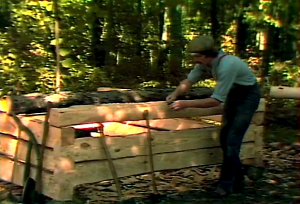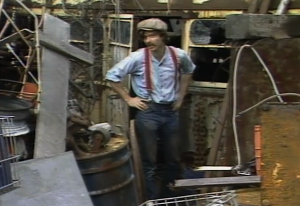The Woodwright Shop Shows Us How Much and How Little Has Changed

Season 1, Episode 8 Where Roy discusses log home building
The woodworking world has been all a buzz about the release of vintage Woodwright Shop episodes through Popular Woodworking. I myself have already pre-ordered the first 2 seasons on DVD. What is even more exciting is that the Shop Class On Demand service Popular Woodworking offers is also streaming Roy’s early seasons on demand anywhere, anytime as long as you have an internet connection (it even works on iPhones and iPads!). So even though I have some DVDs on the way, I modified my current Shop Class subscription to include the Woodwright Channel. I have spent the last week watching seasons 1 and 2 and it is a transformative experience. I think I will keep buying the DVDs as they come available too mainly because streaming has it’s limitations when you want to back up and watch something again or don’t have an Internet connection. Honestly I just like supporting good content and want to do what I can to keep it alive.
What strikes me watching these shows from 32 years ago is just how little has changed in how we do things. This should be no surprise seeing as woodworking has been around for as long as man started using tools. At the same time there are subtle differences in other areas. Even today Roy uses vintage tools he has restored or made himself, but when these early seasons aired that was the only option. Several times he makes mention of where he got his tools and what he did to restore it. He even makes a trip to the junk yard to show how old scrap can be made into tools. I kept thinking about how truly blessed we are today with so many high quality makers of hand tools. While I think something has been lost from our skill sets because we don’t have to make our own froe from a car leaf spring, or by reforging defective ax heads, the barrier to entry for woodworking is so much lower because of all the tools available today.

Roy at the junk yard looking for parts
I’m loving every minute of these episodes but can’t help thinking that I would have been very frustrated watching these in the 1980 and 81 not knowing where or how to get these tools. I’m probably speaking out of turn because today the instant availability of information and merchandise in the Internet age has us all looking through a different filter. I’d like to think I would be motivated to go out and build my own tools, but seeing how much I don’t enjoy doing that now, I’m probably deluding myself.
Another difference is our reliance upon a lumber yard in our supply chain. Roy just wanders out into the forest and cuts down a tree or gets a storm felled tree from a neighbor and goes to work. He does mention that seasoned wood is necessary when he starts building furniture, but much of the first season is using green wood to make things. For that matter, seasoned wood is nothing more than a log riven into boards and set aside to dry for a while. The self sufficiency and knowledge of different wood species properties and which one to use for which task is phenomenal. These are things that have been lost in our “modern” age and hopefully that fact that these episodes are available to see again will keep the knowledge alive.
As a woodworker who spends a lot of time in front of a lens working, I can’t help but continue to be impressed with how naturally Roy shows off his encyclopedic knowledge. To think that 30 years ago when he was in his early 30s (not much younger than I am now) he still had just as much knowledge and skill as he shows today in season 30 of the show is astounding. But he remains approachable. Roy was probably the first woodworker to show mistakes being made (certainly the first one to bleed on air) and his “don’t worry about it” attitude makes woodworking so enchanting. Watching these early episodes makes you want to head into the forest, hug a tree, then ask kindly if you can make it into a Shave Horse. I have done a few live broadcasts before and delivery is always tough. The slow pace of hand tool woodworking makes it hard to get a point across in a short time but Roy does it in one take and make it look easy.
Inspiring, truly inspiring. I cannot say thank you enough to Popular Woodworking and especially to Roy Underhill for making this happen. With only 2 seasons watched, my head is spinning and I cannot wait for more. Roy, if you read this (I know you have stopped by once or twice) thank you from the bottom of my heart for having the crazy idea more than 30 years ago to share your gifts. Your body of work is astounding and you have influenced every woodworker who has ever seen you at work.
By the way, Shop Class on demand is a pretty sweet deal. For $89 you get a 6 month subscription and access to all these Woodwright episodes as well as a huge library of Popular Woodworking DVD titles. New stuff gets put up each week. Put it this way, if you watch it all, you will never get into the shop…hmm think carefully about this purchase.


